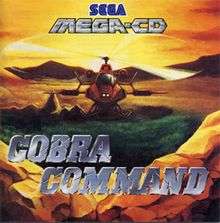Cobra Command (1984 video game)
Cobra Command, known as Thunder Storm (サンダーストーム) in Japan, is an interactive movie originally released by Data East in 1984 as a LaserDisc-based arcade game. A Mega-CD port of Cobra Command developed by Wolf Team was released in 1992.
| Cobra Command | |
|---|---|
 Mega-CD cover | |
| Developer(s) | Data East (arcade) Wolf Team (Mega-CD) Ecseco (Saturn/PS1) |
| Publisher(s) | Data East (arcade) Wolf Team, Sega (Mega-CD) Ecseco (Saturn/PS1) |
| Designer(s) | Yoshihisa Kishimoto |
| Platform(s) | Arcade, Mega-CD, PlayStation, Saturn |
| Release | Arcade
|
| Genre(s) | Interactive movie |
| Mode(s) | Single-player, multiplayer |
Plot
Terrorists are threatening the free world and have amassed a diabolical force. Only the brave pilot of Cobra Command can vanquish the terrorist threat and save the free world from total destruction. The player assumes the role as pilot of the LX-3 Super Cobra helicopter (fictional, but similar to the Bell AH-1 SuperCobra).
The missions go across the New York City streets, the Statue of Liberty, the Atlantic Ocean, Italy, the Grand Canyon and the enemy's headquarters on Easter Island.[1]
Gameplay
The original arcade version is an interactive movie and shooter game, where the player watches scenes as the helicopter flies by the conflict zone. The game screen is represented by the helicopter's cockpit, and the player controls a crosshair that can be moved to aim at the enemy forces. The game features a joystick and two buttons: one Machine Gun and one Missile. The game can be played with 1 or 2 players.
In certain moments, the voice of the pilot's commanding officer helps the player out with completing each mission by firing at enemy forces and dodging both enemy fire and natural surroundings, by pressing the joystick or directional pad in the correct direction and at the right time.
If the pilot makes a mistake, the anime sequence shows the Cobra helicopter blown up and the player loses a life. If all lives are lost, the "Game Over" screen shows the Cobra in smoldering ruins and its pilot is presumably dead from the crash.
Development
Kunio-kun and Double Dragon series creator Yoshihisa Kishimoto designed an entirely new game, Cobra Command, using Data East's Bega's Battle hardware.
Cobra Command was developed by Data East in co-operation with Toei Animation. It was first published in Japan in 1984 as Thunder Storm, then released later the same year in North America as Cobra Command.
Reception
In Japan, Game Machine listed Cobra Command on their May 15, 1984 issue as being the most-successful upright arcade unit of the year.[2]
Reviewing the Sega CD version in Wizard magazine, Glenn Rubenstein praised the high number of levels and unique interface. He gave the game a B-.[3]
On release, Famicom Tsūshin scored the Sega Saturn version of the game 25 out of 40 and the PlayStation version 23 out of 40.[4]
Legacy
Data East released a second game titled Cobra Command in 1988. Unlike the 1984 version, the 1988 arcade game is a side-scrolling shoot-'em-up.
The original Cobra Command was re-released in Japan for the PlayStation and Sega Saturn in 1995 in a two-in-one compilation with Road Blaster, another FMV game produced by the same team.
In November 2009, Revolutionary Concepts developed and published an enhanced iPhone OS version of the original arcade game.
References
- "Cobra Command". Mobygames. 1984. Retrieved 10 June 2014.
- "Game Machine's Best Hit Games 25 - アップライト, コックピット型TVゲーム機 (Upright/Cockpit Videos)". Game Machine (in Japanese). No. 236. Amusement Press, Inc. 15 May 1984. p. 29.
- Rubenstein, Glenn (January 1993). "At the Controls". Wizard. Wizard Entertainment (17): 21–24.
- NEW GAMES CROSS REVIEW: サンダーストーム&ロードブラスター. Weekly Famicom Tsūshin. No.358. Pg.31. 27 October 1995.